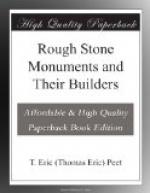Further north is a remarkable group of monuments known as the Carrigalla circles. The first is a plain circle (L) 33 or 34 feet in diameter, composed of twenty-eight stones. The space within them is filled up with earth to form a raised platform. At a distance of 75 feet are two concentric circles, diameters 155 and 184 feet respectively, made of stones 5 or 6 feet high. The space between the two circles is filled with earth. Within these is a third concentric circle about 48 feet in diameter made of stones of the same size. This group of three concentric circles we will call M. The line joining the centres of L and M runs in a direction of 29 deg. or 30 deg. west of north and passes through a stone (N) 8 feet high standing on the top of a ridge 2500 feet away. There are two other stones more to the west (O and P) in such a position that the line joining them (41 deg. west of north) passes through the centre of M, from which they are distant 860 and 1450 feet respectively. Further, a line through the centre of L and a great standing stone (Q) 2480 feet from it in a direction 10 deg. east of south passes through the highest point in the district, 1615 feet away and 492 feet in height.
Mr. Lewis compares this group of monuments with that of Stanton Drew in Somersetshire. In both a line joining the centre of two circles passes through a single stone in a northerly direction, and there is in both a fixed line from the centre of the larger circle. Captain Boyle Somerville, R.N., finds that the line 29 deg. or 30 deg. west of north would mark the setting of Capella in B.C. 1600, or Arcturus 500 B.C.; he adds that the direction 41 deg. west of north would suit Capella in 2500 B.C. or Castor in 2000 B.C.
On the west side of Lough Gur is another group of monuments. There is in the first place a circle 55 feet in diameter. On a line 35 deg. east of north from this is a stone 10 feet high, and the same line produced strikes a prominent hill-top. Somewhere to the south-west of this circle, perhaps with its centre in the line just described, lay a second circle between 150 and 170 feet in diameter, destroyed in 1870. Three other stones mentioned by early writers as being near the circles have now disappeared. The direction 35 deg. east of north is the same as that of the King-stone with regard to the Rollright Circle in Oxfordshire. This line, allowing a height of 3 deg. for the horizon, would, according to Sir Norman Lockyer, have struck the rising points of Capella in 1700 B.C. and Arcturus in 500 B.C.
To the south of the destroyed circle is another about 150 to 155 feet in diameter, with stones of over 5 feet in height set close together. Earth is piled up outside them to form a bank 30 feet wide. There is an entrance 3 feet wide in a direction 59 deg. east of north from the centre of the circle. There is said to have been at one time a cromlech 100 feet wide due south of the circle and connected with it by a paved way. Sir Norman Lockyer thinks that the position of the doorway is connected with observation of the sun’s rising in May. Moreover, the tallest stone of the circle, 9 feet high, is 30 deg. east of north from the centre, a direction which according to him points to the rising of Capella in 1950 B.C. and Arcturus in 280 B.C.




